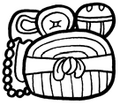| Yax Nuun Ahiin II | |
|---|---|
| Ajaw | |
 Yax Nuun Ahiin II's portrait on Stela 22 | |
| King of Tikal | |
| Reign | 25 December 768 - c.794 |
| Predecessor | 28th Ruler |
| Successor | Nuun Ujol K'inich |
| Born | before 768 Tikal |
| Died | c.794 Tikal |
| Father | Yik'in Chan K'awiil |
| Religion | Maya religion |
| Signature |  |
Yax Nuun Ahiin II [N 1] also known as Ruler C and Chitam, (before 768-c.794), was an ajaw of the Maya city of Tikal. He took the throne on December 25, 768 and reigning probably until his death. [N 2] He was son of Yik'in Chan K'awiil and brother of 28th Ruler. The monuments associated with Yax Nuun Ahiin II are: Stelae 19, 21 and Altars 6 and 10. [1] [2]
